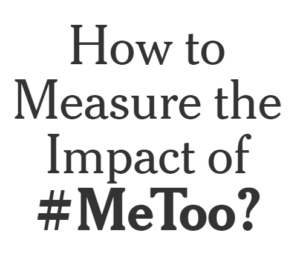How To Measure the Impact of #MeToo?
Last spring, the fate of an entire global movement was decided in a single Virginia courtroom. Or so the story went.
The actors and ex-spouses Amber Heard and Johnny Depp were dueling over defamation charges. An online mob swarmed Ms. Heard. Many observers feared that other women would be intimidated from airing abuse allegations. Even before a jury decided the case mostly in Mr. Depp’s favor, obituaries for #Metoo began to appear, including in this newspaper.
“This is basically the end of MeToo,” a psychologist told Rolling Stone after the verdict. “It’s the death of the whole movement.”
The #MeToo mourners came to that conclusion even though the actors’ trial layered allegations of sexual and domestic violence with other elements — thermonuclear divorce, celebrity spectacle. Few commenters cited another story from that week: a bombshell report from the Southern Baptist Convention admitting that high-ranking church leaders had suppressed and mishandled allegations of abuse of women and children within its ranks over two decades. The group soon revealed a file more than 200 pages long, describing hundreds of accused ministers and other church workers. The reckoning, across the nation’s largest Protestant denomination, was a broader, deeper #MeToo event than the celebrity courtroom battle, and a sign of the movement’s durability.
Five years after the #MeToo movement exploded into a global phenomenon, its success is inherently hard to measure.
The conventional way to score it follows whatever prominent accused man is falling or prevailing at the time. Harvey Weinstein is sent to prison; Bill Cosby walks free. Andrew M. Cuomo resigns; R. Kelly is convicted.
“It’s up and down and up and down all the time,” said Tarana Burke, who founded the #MeToo movement in 2006, to seek healing for Black women who suffered sexual abuse.
After The New York Times and The New Yorker revealed the allegations against Mr. Weinstein in October 2017, the phrase #MeToo didn’t just go viral — it also expanded. Ms. Burke watched as the term she had coined was used in ways that went far beyond her organization and mission. People used it to describe not only rape and workplace sexual harassment, but also domestic violence, gender bias and verbal abuse.
However, the malleability that has given #MeToo power and influence also makes it a challenge even for supporters to define clear objectives or tabulate gains and losses.
Take two episodes from this year. In April, Louis C.K. won a Grammy, provoking cringes from many fellow comedians, fans and others, especially as his accusers — female comedians with nowhere near his clout — continued to struggle. But his is also arguably one of the most settled #MeToo stories, because he admitted that the allegations against him were true. The lingering controversy is less about the facts than about whether he has been adequately punished.
After claims of sexual misconduct against the N.F.L. quarterback Deshaun Watson mounted in 2021, the Cleveland Browns signed him to a $230 million fully guaranteed contract, prompting complaints that the league wasn’t taking the allegations seriously and didn’t care about women. But this past summer, after a league investigation found that Mr. Watson had committed multiple violations of its personal conduct policy, the quarterback was suspended for 11 games and fined a record $5 million. While some saw the penalties as a slap on the wrist, they were among the most severe in league history.
These stories are shape shifters, evidence of #MeToo’s endurance or its waning influence.
